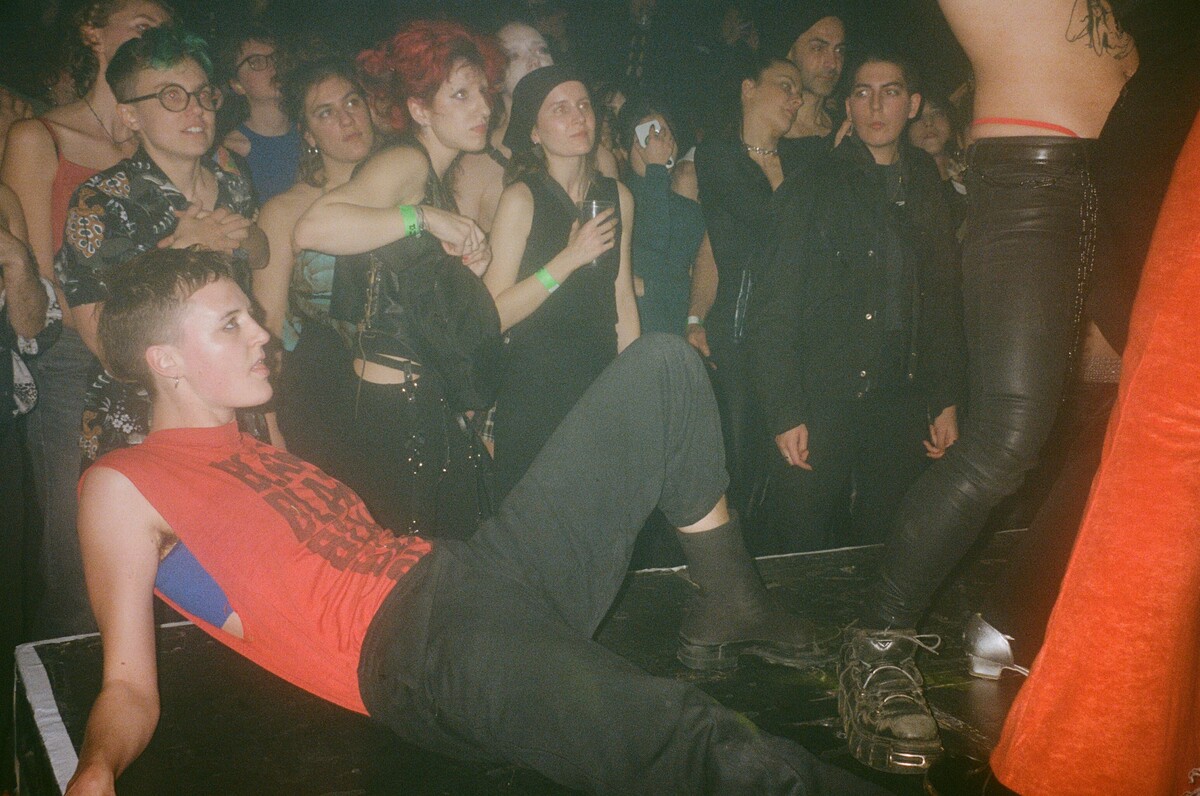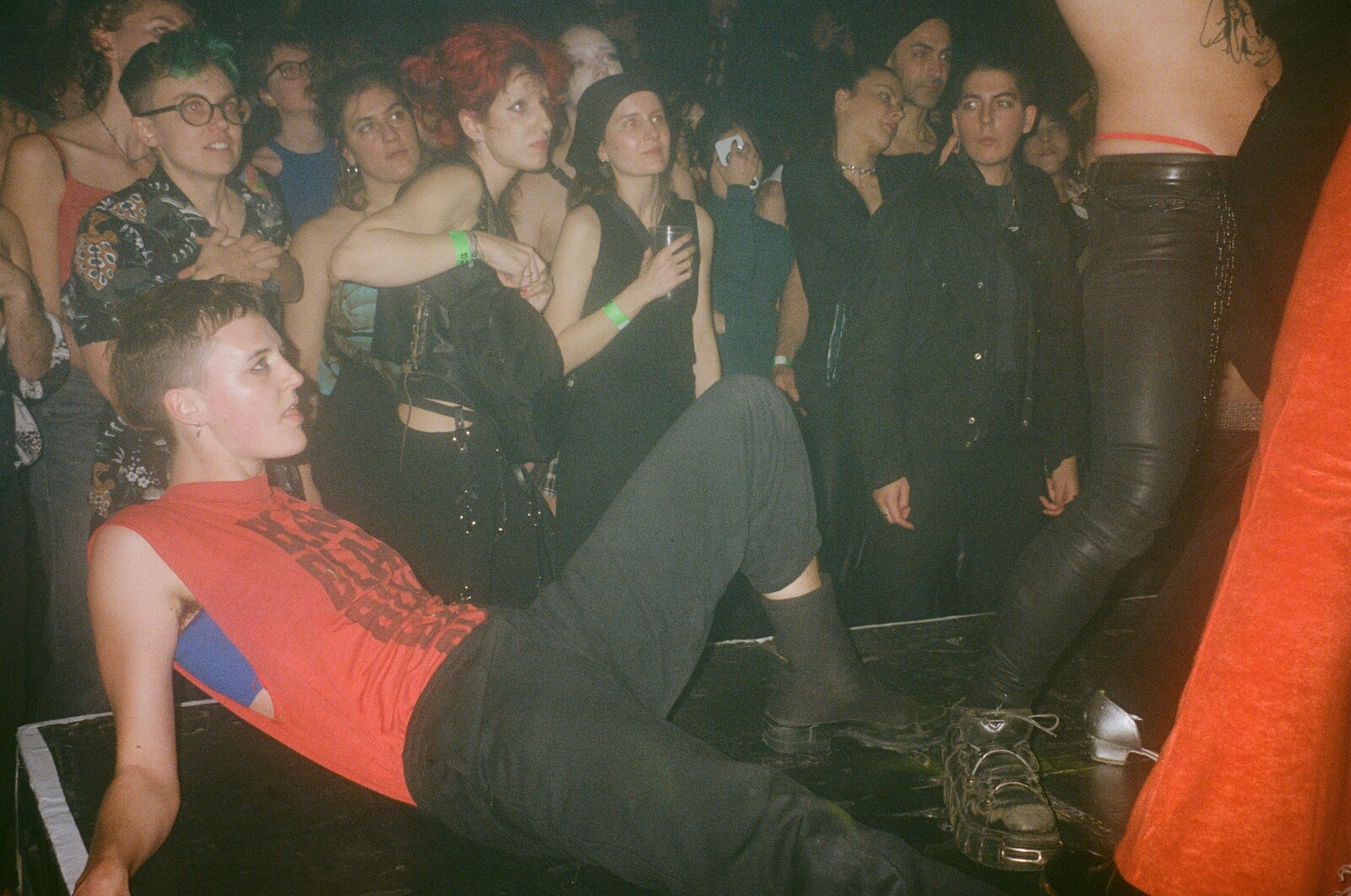At the end of last year, the performance work Dyke, Just Do It (Excerpt) premiered as part of the roving queer rave INFERNO, hosted for the second time at London’s Institute of Contemporary Arts.1 An ensemble of self-identified dykes writhed, kissed, and ripped a button-down shirt, while glitching monitors and a towering projection flickered between footage of the virile bodies, commanding slogans, and images produced through designer and director Sweatmother’s “triple-baked method,” which uses a synthesiser to warp and interact with live audio and visuals of the performers in real time. Dyke stages a version of queer sex inside the rave; a performance of sexuality which blurs the lines between diegetic and “real” desire, as the non-professional dancers turn back into ravers and even the screens could be mistaken for high-concept club design. Dyke references LGBT kiss-ins, where gay desire becomes a public theater of protest, spectacularized but not faked. Placing these gestures alongside the visual language of advertising, Dyke speculates on the possibility of seeing the media’s voyeuristic commercialization of lesbianism through the same lens, reimagining these representations of queer desire as part of a sincere, underground economy of identification.
The commercialization of queerness is not only present in Dyke’s material, but also shapes its context. The nightclub is a commercial space in which desire is turned toward the profit motive. Yet Dyke took place within a publicly funded cultural institution, one that was acting as a club for the night. This mingling of art space and nightlife is not an isolated example in London’s queer scene. In early 2022, Canning Town’s FOLD ran the first series of “Futur.shock,” a multi-disciplinary platform supporting contemporary art and music within a club environment; Somerset House invited queer ESEA rave GGI 끼 to guest DJ at their 2022 summer festival; and, aside from guest nights like INFERNO, the ICA hosts a roster of DJs and collectives as part of their monthly late program. Why are contemporary art spaces in London turning to queer raves, and why are these parties seeking such institutions to support them? And what is said in this trend about the relationship between queerness, its representation, and profit in the British culture industries?
Queer and trans communities’ relationships to culture are often described with spatial metaphors that mark our production and consumption as outside of the mainstream. Prefaces like “sub,” “marginal,” even “night” speak not only to the removal of queer practices, but also contain a moral and aesthetic judgement which places queerness as below, irrelevant, or dangerous to conventional culture. This position, always in relation to the center but never central, is itself an important source of queer forms of expression. Jack Halberstam’s In A Queer Time and Place (2005) speaks of this as a “style,” a creative and intuitive relationship to culture that allows queer people to exist as such, given how our subjectivities are themselves imaginative projects.
Artists like Sweatmother are connecting to and re-enlivening a rich heritage: we could see Dyke in relation to the work of lesbian performance troupe Split Britches, or the photographer Tessa Boffin’s Crucifixion Cabaret, performed at gay nightclub Purgatory in 1992. But what is altered in the move from Purgatory to INFERNO? Lately, queer studies departments have been turning their attention to the intersection between their discipline and Black and brown nightlife. Scholars such as madison moore, a DJ and assistant professor at the University of Southern California, bring their embodied knowledge into the academy, and increasingly, into spaces of contemporary art. Alongside McKenzie Wark, moore is co-editor of a special issue of e-flux Journal titled “Black Rave,” published in the same month as Dyke’s first outing. The contributions do not necessarily frame these musical cultures as contemporary art, but implicit in the publication is a reassessment of the status of techno and the queer party which places them at least adjacent to, if not within, the expanded field of art and theory.
This move stakes a counterclaim against the historic attempt to devalue and censor these modes of expression and imagination, reasserting a history that has been strategically straightened and whitewashed, giving roses and resources to whom they are long overdue. Yet there is also a sense that this is the context now; the staging of queer raves in publicly funded museums is not simply a political move, but a mutual convergence of the queer club scene and the art world—an effect of having people like moore with a foot in both camps. Sara Sassanelli, curator of Live programming for the ICA, told me that the position gives them the opportunity to combine their experiences in both more conventional after-hours programming and in the London club scene, allowing more creativity and flexibility with form.2
In 2023, queer people in London have been forced to get creative. Decades of development has meant the almost total loss of LGBTQ venues: research conducted by UCL found that between 2006 and 2017, 58 per cent of London’s queer venues closed their doors for the final time.3 Institutions like the ICA are therefore fulfilling a real need—but also achieving a great benefit. Many galleries and museums are leaning toward more ambitious after-hours programming to pull in greater audiences and funds. Public programming has a long history of being used to fill diversity quotas, as its lower commitment and faster turnover make it easier to adapt than acquisition or exhibition policies. More diverse artists leads to more diverse audiences, growing the potential market and therefore ticket sales. However, inclusivity is increasingly a condition of national funding. In 2021, Arts Council England announced its new investment principles, which alongside “Inclusivity and Relevance” called for organisations to exhibit “Dynamism,” responding to audience wants and becoming more entrepreneurial with their mission and business model.
In this context, Dyke’s comment on queer commercialism reads differently. It is not simply that desire can generate income, but sexualized identity itself has become a source of cultural capital for non-profit institutions—a move that risks neutralizing this culture’s oppositional position, and smoothing over the very real violence faced by queer people in cultural spaces (consider recent clashes outside the Tate Britain over a drag queen story hour).4 Sweatmother and his collaborators are aware of this; the provisional nature of the performance, and the choice to not use professional dancers, speaks to how little reframing and processing needs to be done in the museum to make queer bodies into fetishized and profitable objects—our presence alone is enough to create cultural capital or controversy. But just as queer people operate from within academic and artistic institutions producing the discursive and material conditions for these performances, we also operate inside this economy of desire—this was after all, a queer-centered night. Our hotness is finally hot property, and we may enjoy it and use it while it lasts. However, the question remains: if we are going to enact our pleasure in these contexts, how do we do it for ourselves?
In November 2022, Hackney nightclub Colour Factory hosted a screening of the t4t experimental porn film Under a Bleeding Horizon, a collaboration between the artists and adult performers Coyote Park and Eric Shen. The event was a fundraiser to recoup production costs and was organised by June Lam, founder of queer ESEA rave GGI 끼 and one of the film’s producers (Shen is an alias). Like GGI 끼’s nights, the screening centered community, offering trans, femme, and queer people of color a place for healing and joy in a landscape that often alienates and fetishizes these identities. Lam creates this environment through formal conditions to mediate entrance, such as tiered ticketing and ensuring a trans person is present to check IDs, but also in the film itself.
Under a Bleeding Horizon is lush and romantic. Chen and Park caress each other in a sunken arena lit softly from above and furnished with foliage, moss, and water, like a well in the middle of a forest clearing. As in Dyke, this abstracted and illuminated landscape could be a representation of the club. We see dark pillars and rigs in the background, making us aware that this is a theatrical space, a stage. But unlike Dyke, this is not the club, or if it is, it is a model of it, a model under different conditions.
Under answers the transformational call of t4t intimacy, asking what changes are possible when we see each other, and when we let ourselves be guided by this mutual sight. Art like this, that hews close to desire, can model feelings in a space, providing another way of connecting with ourselves and each other. And in a DIY context, this connection is not the site of extraction: any value generated goes back into the film, any desire shared out between the people in the room. When art is put within the queer rave, rather than the queer rave within the art gallery, we get to make this offer and receive it ourselves. To reclaim our joy and sexuality from commercialism it is necessary to figure out how to operate within and take from the institutions that will host us, while also continuing to create other spaces to party and dream.
Dyke was designed and directed by visual artist Sweatmother, with movement direction by Eve Stainton and sound by Jennifer Walton.
Sara Sassanelli in conversation with the author.
Ben Campkin and Laura Marshall, “LGBTQ+ Cultural Infrastructure in London: Night Venues, 2006–present,” UCL Urban Laboratory (July 2017), https://www.ucl.ac.uk/urban-lab/sites/urban-lab/files/LGBTQ_cultural_infrastructure_in_London_nightlife_venues_2006_to_the_present.pdf.
“Protest at Tate Britain over drag queen children’s story event,” BBC News (February 2023), https://www.bbc.com/news/uk-england-london-64610724.


